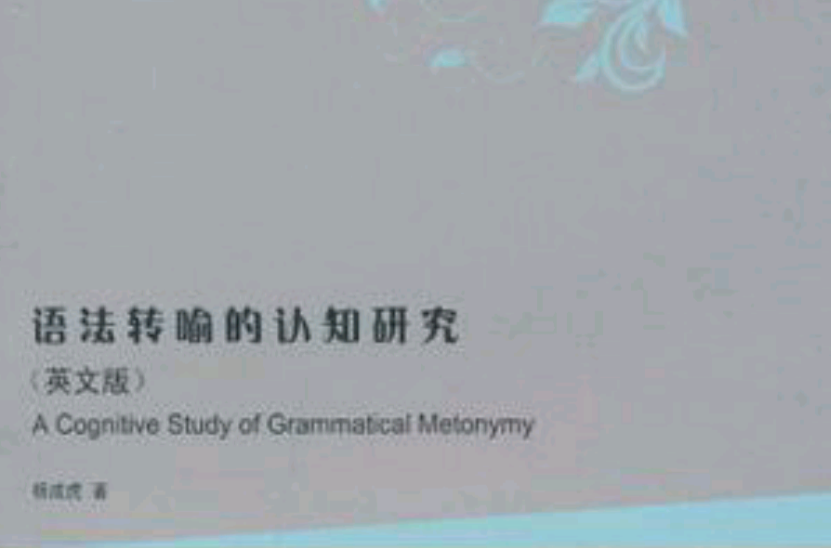《語法轉喻的認知研究》是2011年上海交通大學出版社出版的圖書,作者是楊成虎。
基本介紹
- 書名:語法轉喻的認知研究
- 又名:叢書名: 當代語言學研究文庫
- 原版名稱:A Cognitive Study of Grammatical Metonymy
- 頁數:281頁
- 出版社:上海交通大學出版社
- 出版時間:第1版 (2011年1月1日)
- 裝幀:平裝
- 開本:16
- 正文語種: :英語

《語法轉喻的認知研究》是2011年上海交通大學出版社出版的圖書,作者是楊成虎。
《英漢語動賓結構的語法轉喻研究》是2015年6月上海交通大學出版社出版的圖書,作者是楊成虎。內容簡介 《英漢語動賓結構的語法轉喻研究》從辭彙化的角度研究了英漢語動賓結構的句法和語義關係。動賓結構均可以通過辭彙化合併相關語義,改變...
《英漢指稱轉喻意義建構的認知語用研究》是暨南大學出版社出版的圖書,作者是江曉紅 內容簡介 本書為何自然先生主編的語用學學人文庫之一,從認知語用學的角度,運用思辨和語言直覺輔以語料分析和實證研究方法,對轉喻的理解、使用和習得的...
《認知轉喻》是2010年7月上海外語教育出版社出版的圖書,作者是張輝,盧衛中。本書共分為六部分、十八章,分別就轉喻的本質和分類、轉喻和隱喻之間的關係、辭彙和語法的轉喻理據、轉喻與語用、轉喻與語篇分析以及轉喻與文學和翻譯等話題...
《認知語用研究:辭彙轉喻的理解》是2009年5月1日中國社會科學出版社出版的圖書,作者是江曉紅。內容簡介 《認知語用研究:辭彙轉喻的理解》觀點新穎、立意深刻、層次分明、引證翔實、語言流暢,具有較強的可讀性和較高的學術參考價值。《...
《認知視角下人體詞的語義轉移研究》是國防工業出版社於2014年出版的一本圖書,作者是趙學德。內容簡介 全書以英漢人體詞為研究對象,展開系統與綜合性的語義轉移研究,嘗試在認知模式下構建人體詞連續統一的語義轉移網路,以便發掘人體部位突顯...
數量詞對語法結構起制約作用的原因;漢語“的”字結構轉指中心語的現象本質上一種“語法轉喻”;動詞配價研究中存在的問題及其原因……這裡收集的14篇文章都是發表過的,就按各篇發表年份的順序排列。目錄 序 “有界”與“無界”(...
5.3.2 基於轉喻的創新複合詞 5.3.3 基於隱喻、轉喻互動的創新複合詞 5.4 轉化構詞法 5.5 小結 第六章 隱喻、轉喻與語法 6.1 引言 6.2 語法隱喻和語法轉喻的含義和工作假設 6.2.1 語法隱喻及工作假設(i)6.2...
1.3.4 認知語義學理論 22 1.3.5 心理空間理論和概念整合理論 30 1.3.6 認知語法理論 33 1.4 結語 38 第2章 新時代認知語言學的發展與創新 39 2.1 隱喻/ 轉喻研究 40 2.1.1 隱喻/ 轉喻研究進展概述 40 2....
《隱喻轉喻研究》是2011年6月1日上海外語教育出版社出版的圖書,作者是束定芳。內容簡介 “中國認知語言學研究論文集系列”精選了近20年來國內語言類刊物上發表的有關認知語言學的代表性論文,共有五個分冊。本系列集中展示了中國認知語言...
認知辭書學引論王仁強 後現代哲學視野下的多模態認知研究——以《國王的演講》電影海報為例 王天翼 中國後語言哲學視野中的多模態語篇研究——多模態隱轉喻認知觀 崔 鑒 對比研究需要前沿理論,理論創新促發對比研究——認知對比語言學...
《轉喻在新聞語篇中的組織功能》是2016年6月山東大學出版社出版的圖書,作者是戴理敏。內容簡介 《轉喻在新聞語篇中的組織功能》對真實語料進行分析,將轉喻在辭彙及句法層面的研究延伸到語篇層面,結合功能語言學與認知語言學的研究方法,...
《語法隱喻視角下漢英錯位修飾現象研究》以系統功能語言學的三大純理功能為基本框架,融合了認知語言學的意象圖式、隱轉喻、主觀性、象似性等理論與方法,從詞組、小句、篇章等層面對比分析了漢語和英語中錯位修飾狀語和錯位修飾定語的共性...
人們在日常交際中都需要訴諸隱喻來表征這些理念;曰其“跨域”,是指隱喻與其他學科門類或項目如習語、語法隱喻、轉喻、外語教學、翻譯等同樣密不可分,可以藉助認知隱喻學的理論成果對其本質進行重新審視,加深認識和理解。
31.轉喻概念映射之意義釋解.《外國語言文學研究》2007,(3).32.國中英語教材評析與選用建議.《中國小英語教育》2006, (4).33.轉喻:從“辭格”到認知研究的回顧. (CSSCI). 《外語與外語教學》2005,(8).34.《轉喻、語法與...
